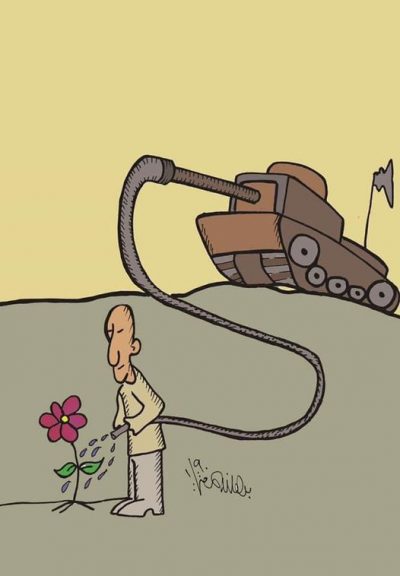Iraq in the American Imagination Today

All Global Research articles can be read in 27 languages by activating the “Translate Website” drop down menu on the top banner of our home page (Desktop version).
***
Should we thank Pope Francis’ invitation to the world to stare into the maw of the Iraqi landscape? Whatever image the holy man conjures with his blessings, it can hardly be more than a fleeting one.
What remains, what might endure, what might rise and be restored–is unspeakable for Americans. A blast of yellow dust obscures the present, replaced by a soft image of robed clerics wandering through ancient Mesopotamia.
Among old timers familiar with Middle East archeology, Iraq was simple– an exotic Mesopotamian desert. It yielded scientific discoveries and allowed the removal of unparalleled creations to distant museums; it inspired novels by Agatha Christie. Oil, a collateral benefit of intellectual explorations, emerged from Mesopotamia.
Today, that place has neither oil nor people…to speak of. It’s reverted to an unthreatening, legendary land: a page in American school texts, a museum lecture. Those lessons, stripped of inhabitants, are illustrated mythical beasts and ancient minarets, brick walls cemented with 4000-year-old bitumen mortar. If that ancient place produced the world’s earliest known written novel, the first inscribed legal code, those items don’t fit the allotted page entry.
In the imagination of Americans, the name Iraq is not really a country or a desert, not a democracy or a multi-ethnic nation, not a theater-of-war or a cemetery of past patriots.
The reference belongs to a fellow American, an undisputedly brave “thank-you-for-your-service” recipient. In his late 30s now, he’ll earn more accolades if victim of an IED –not clean sniper bullets, but something terroristic. If he’s diagnosed with PTSD, he’s secured employment upon retirement. Combat trauma excuses his rage, explains his domestic abuse, references his murder of fellow Americans– co-veterans, neighbors, family—and his drug addiction.
He becomes a pitiable, troubled film hero who displays immense willpower, despite his misdeeds. Or he emerges into a political candidate.
Iraq veteran is a badge of honor, a qualification, for wannabe U.S. politicians today (whatever their party affiliation). Presidential candidates Tulsi Gabbard and Pete Buttigieg boasted war experience. Across the country today, party committees scour towns and neighborhoods to identify such noble figures.
A nearby village hosts a brewery called “Do Good”. The manager explains “Do Good” honors his deceased friend; “He was a sniper in Iraq. Do Good is what he always advocated.”
This transformation from killer-sniper to symbol of democracy took hardly a decade, helped initially by best-selling soldier-authored poetry collections and memoirs, then by Hollywood. Any voter will recall films where American boys emerge valorous: defusing bombs, saving comrades, opening Christmas packages from home, craving fried chicken, caressing photos of newborn children.
To prepare for the glory and pain, the losses and merciless heat, the rigorous sniper training and persistent fear, Mesopotamia needed to be transformed from the benign to the menacing. Kept under the radar, far from American public view, Mesopotamian lads were mobilized against Iranians their own age, enemies along a shared frontier. No Shia or Sunni in Iraq then, only wrathful extremists who’d ousted Washington’s dictator in Tehran.
Never mind the name of a young, promising military officer who sent hardy farm boys into marshy borderlands for face-to-face combat. He gladly took on “religious fanatics”, having earlier served America with his quiet purge of Iraq’s communists.
After 1988 when the two neighbors ended their conflict, Iraq became “The Regime”. Occasionally a real person would emerge with a new memoir of torture under this regime’s “Republican Guard”. Even today, that demon remains more threatening than any Marine-managed torture prison or helicopter gunship firing at children.
“The Regime” became the terror behind the exodus of intellectuals that continues up to today. Uncounted. Highly reputed doctors, renowned engineers, language and history scholars slip away, welcomed by western hospitals and universities after each has somehow managed fees and endured low paid retraining to settle, hushed, in a Michigan or California suburb.
Who won that 1980s border war hardly matters. Kuwait emerged as the victor, defining a new Hitler for the U.S. imagination. How robustly the grimacing face of Saddam gripped the US imagination! Thirty allied nations rallied behind Washington’s call to liberate Kuwait. The global assault was spectacular and efficient—forget about sons and brothers lost on those borders. Forget about the following thirteen silent years while a relentless blockade took a toll greater than any battlefield. Without signs of blood and no American lost, only Iraqi children offered an occasional statistic of malnutrition, disease, or cancer deaths. The quietly murderous U.N. embargowas hardly eventful.
Good Iraq became Kurdistan; some oppressed Shiaa in a triangle of dusty desert pleaded for emancipation. (Nothing about women.) Mesopotamia, modern hospitals, bustling universities, family excursions to Europe and scientific conferences ceded to Saddam and his Republican Guards.
Finally, a motive was found for a full-scale invasion. Was it weapons of mass destruction? Something related to Al-Qaeda’s 9/11 attack? Or the singular Saddam demon? Minorities needing liberation, craving democracy?
A new generation of journalists headed eastward. Prize-winning books followed.
More medics and teachers disappeared. More young people forgot about education, Olympic training, sculpturing, or cultivating their Mesopotamian soil.
Pillaging and killing were massive, but no heart was won. Local newspapers and new television companies flourished and villagers brandished their purple thumbs. Prime-ministers changed seats while whoever was left became Shia-Sunni, Yazidi or Chaldean, Al-Qaeda-ISIS-Daesh.
Exhausted, the Mesopotamian dust settles over another layer of outstanding civilization.
*
Note to readers: please click the share buttons above or below. Forward this article to your email lists. Crosspost on your blog site, internet forums. etc.
BN Aziz whose anthropological research has focused on the peoples of the Himalayas is the author of the newly published “Yogmaya and Durga Devi: Rebel Women of Nepal”, available on Amazon.
All images in this article are from the author


